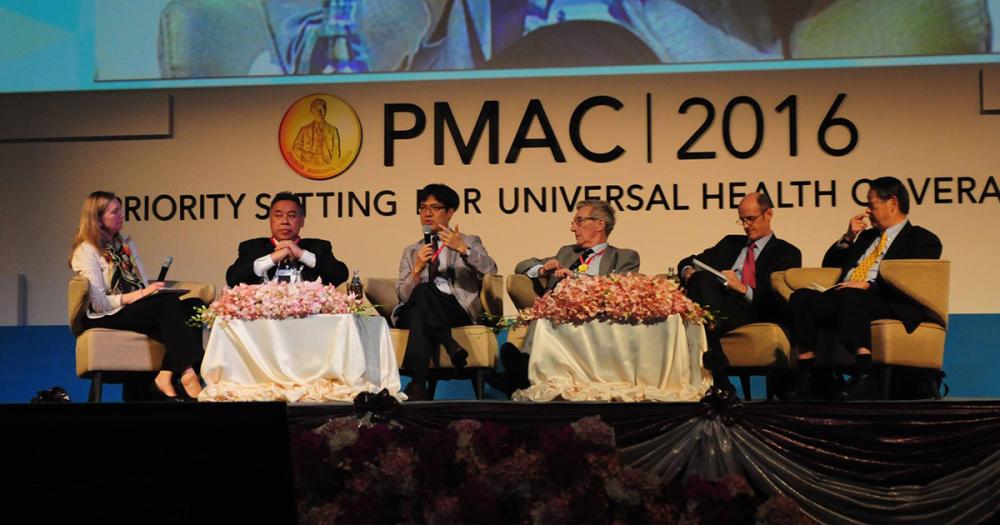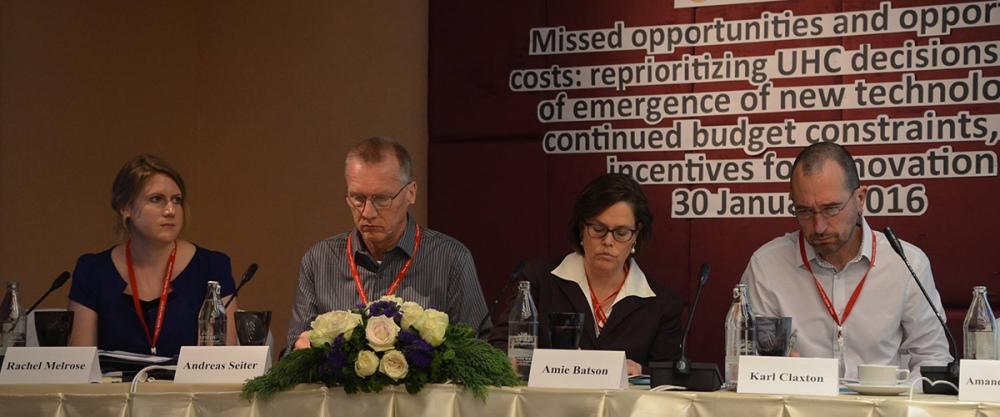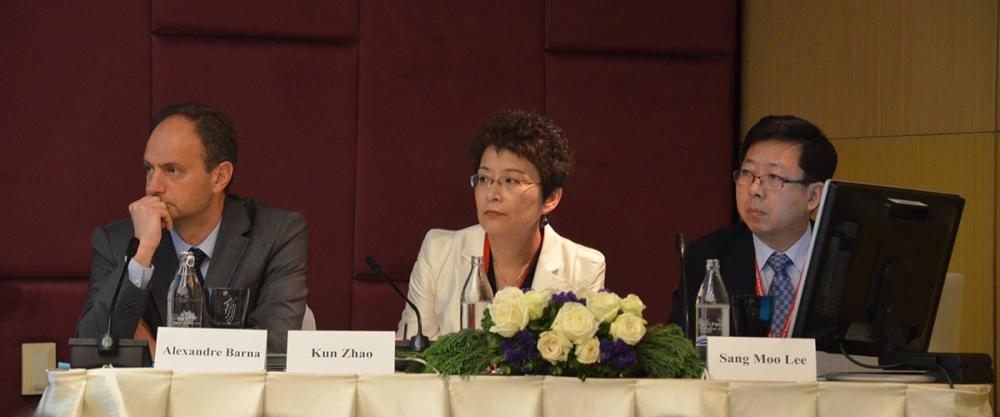The topic of priority-setting has gained some serious momentum since CGD’s 2012 seminal working group report: in January, nearly 1,000 policymakers, practitioners, researchers, donors, and advocates gathered at the 2016 Prince Mahidol Awards Conference (PMAC) in Bangkok, Thailand, to discuss priority-setting for universal health coverage (UHC).
Representatives of global organizations and government health agencies of low- and middle-income countries (LMICs) kicked off the conference in an opening plenary (pictured below), recognizing the importance of priority-setting as demands for health services increase in limited resource environments. And the Bill and Melinda Gates Foundation announced additional support to the International Decision Support Initiative, set up in 2013 following CGD’s report (see recent our blog post and podcast for more about why this is such great news).

Pictured: Opening plenary, moderated by Amanda Glassman (CGD) with Untung Suseno Stuarjo (Secretary General, Ministry of Health, Indonesia), Soonman Kwon (Professor and Dean of the School of Public Health, Seoul National University, Republic of Korea), Michael Rawlins (Former Chair, NICE, United Kingdom), Tim Evans (Senior Director for Health, Nutrition and Population, World Bank), and Lincoln Chen (President, China Medical Board)
CGD was pleased to help organize several sessions, including one titled, "Missed opportunities and opportunity costs: reprioritizing UHC decisions in light of emergence of new technologies and continued budget constraints." Here are a few takeaways from the session:
"Old" technologies can be "new" for low- and middle-income countries
The pace of technological growth in health is quick: each year, large numbers of new medicines and devices enter global markets. While some new technologies can be cost-saving or extend lives, others can be effective but extremely costly, and still others are just costly without being transformational for UHC goals.
Meanwhile, public resources available for health, even if they see an uptick, don’t increase at the same pace as the availability of new technologies. As a result, adoption of a new technology may imply disinvestment and reallocation away from other uses of public monies or crowding out of more cost-effective uses of spending toward UHC goals.
It is therefore important for LMICs to keep in mind that some technologies that have been available in other countries can still be "new" to their health systems—and to give those technologies the same consideration as the shiny new ones. As Kun Zhao, director of health technology assessment at the China National Health Development Research Center, put it, "your ‘old’ can still be ‘new’ for me." Investing in these older, potentially more cost-effective, technologies could be an opportunity for LMICs to enhance value for money.
Priority-setting has a role in global health
The decision to adopt an intervention or not is one challenge; knowing what’s on the market or potentially coming to market is another.
We’re seeing more and more innovation—defined by Amie Batson, chief strategy officer at PATH, as "not just the new and expensive, but new approaches that significantly affect access and effectiveness compared to standard of care"—in LMICs, by those who understand the needs of the poor. And, as Batson underscored, it is important that LMICs are able to identify and adapt the innovations that are appropriate for their health systems.
When it comes to these new innovations, Alexandre Barna, head of unit at CEDIT, France and representative of the EuroScan Network, and Sang Moo Lee, executive director in the Office of Research Planning at NECA Korea, showed that health technology assessment and horizon scanning are part of the process and highlighted resources available to all countries to support priority-setting. For example, EuroScan provides a collaborative platform to share information on emerging health technologies; South Korea uses a modified version of EuroScan’s toolkit to identify and assess new technologies.
Priority-setting can make new products more affordable
The Pharmaceutical Management Agency of New Zealand (PHARMAC) uses a relative prioritization list of medicines (using a QALYs per $1 million metric) and is uniquely legally mandated to stay within a certain budget. As such, despite a relatively small population which can mean less leverage, PHARMAC has the ability to negotiate very low drug prices. Rachel Melrose, manager of the policy team at PHARMAC, showed us the result: prices of the 30 most commonly prescribed drugs in New Zealand are one-third of the cost in the US, and actual total drug expenditure in 2014 was less than half of the estimated expenditure.
Be mindful of incentives for innovation
What incentives for innovation are created by priority-setting? What are potential unintended consequences of priority-setting? "What if health technology assessment and if all the bureaucratic controlling of new products stifles innovation?" Andreas Seiter, senior health specialist at the World Bank, asked. "Investors might take their money to other sectors. How would we know whether this was happening?" These are important questions to consider.
"If we want to support innovation," Karl Claxton, a professor in the Department of Economics and the Centre for Health Economics at the University of York, argued, "give a strong signal of what we’re able to pay." His research on how new technologies can displace existing, potentially more cost-effective uses of public health funds provides one method for how countries could arrive at a "willingness to pay" benchmark for a new technology. With awareness of such a benchmark, external assistance can be focused on where it’s required (i.e., where countries can’t pay the generic costs); donors can target funding where there isn’t incentive for manufacturers; and health systems can access new technologies.
As priority-setting remains firmly part of the UHC agenda, we at CGD are excited to continue thinking about these topics and engaging with the International Decision Support Initiative (iDSI) as it scales up. In the meantime, we encourage you to check out the presentations from our PMAC session here and from all other sessions here.


Pictured: Parallel Session 2.2 panelists – Rachel Melrose (Policy Team, PHARMAC New Zealand), Andreas Seiter (Senior Health Specialist, World Bank), Amie Batson (Chief Strategy Officer, PATH), Karl Claxton (Professor, University of York UK), Alexandre Barna (Head of Unit, CEDIT France), Kun Zhao (Director of HTA, CNHDRC China), Sang Moo Lee (Executive Director, Office of Research Planning, NECA Korea)
Disclaimer
CGD blog posts reflect the views of the authors, drawing on prior research and experience in their areas of expertise. CGD is a nonpartisan, independent organization and does not take institutional positions.





